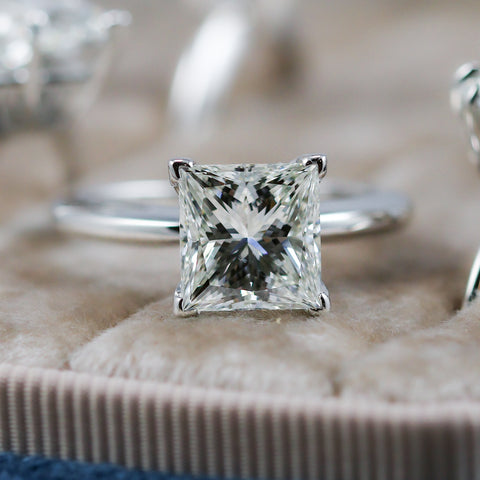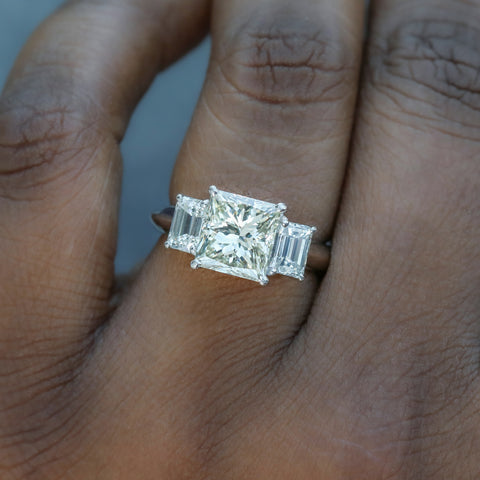
Princess Cut
Known for its square or rectangular shape and brilliant faceting, the princess cut (aka “square modified brilliant”) offers a unique blend of elegance and modernity. While square cut stones like the French cut and the Carre cut existed, a lot of time passed before there was an option for a square cut stone that could maximize light reflection and offer a contemporary alternative to traditional diamond shapes like the round or emerald cut.
The Original Princess Cut
The story of the princess cut first begins in 1961 when a diamond cutter from England, Arpad Nagy, created a square design, which he called the “princess cut”. This stone was square, but it didn’t have the same level of faceting underneath as a modern princess cut, and the name didn’t really catch on at the time. Eventually, he opted to change the name to the “profile cut”. One of the biggest differences in the design of the modern princess cut and the profile cut is that the princess cut is a much deeper stone. The modern day princess cut is more focused on maximizing brilliance, whereas the profile cut made a diamond appear larger.
Bridging the Gap – The Barion Cut
Fast forward a few years to 1971, and South African diamond cutter, Basil Watermeyer, patented what he referred to as the “Barion Cut”, named by combining his and his wife Marion’s names. The Barion cut is actually a family of cuts, rather than a specific shape. Basil’s original goal was to find a way to cut elongated brilliant cut stones and reduce the light escape (commonly referred to as a bowtie effect) that is so common with oval and other elongated diamond cuts. The innovation behind the Barion cut was that it was one of the first “mixed cuts”, which is a combination of step and brilliant cuts on the pavilion.
A New Princess Cut
Fascinated by the Barion cut, but aspiring to create something easier to replicate, a team of Israeli diamond cutters, Betzalel Ambar, Ygal Perlmanand Israel Itzkowitz, created the “Quadrillion cut”, which only had 49 facets compared to the Barion’s 80+. The Quadrillion cut was originally created in the early 1970s, and following the invention of the “Radiant cut”, these diamond cutters were inspired to come together and perfect their design. The newly revised “Princess Cut”, containing 50-58 unique chevron pattern facets, officially made its debut in 1979.
Over time, there have been many reinventions of this design. There are multiple patents filed for different “princess cut” diamond styles, most commonly differentiated based on the number of facets and the angles of each facet.
Advantages of Princess Cut Diamonds
As the Art Deco movement of the 1920s-30s was revived within the Modernist period of the 1960s-70s, this square shaped brilliant stone took off in popularity. Not only were these diamonds unique in their ability to form a sharp angled, modern looking square and sparkle like a round brilliant, they actually look bigger when their weight is compared to that of a round brilliant cut diamond of equal weight.
Because of their brilliance, princess cut diamonds are also really great at hiding inclusions. A princess cut does a much better job than a lot of other stones. This makes princess cut diamonds a great choice for “I1” clarity stones, which may show noticeable inclusions with other cutting styles.
Another attractive aspect (to the people mining and cutting the diamonds at least) of the princess cut diamond is that it is capable of using up to 80% of the rough material. This is a greater percentage of the rough than any other diamond cut.
Ideal Measurements
The “ideal measurements” for a princess cut diamond is a stone with a length to width ratio of 1.00-1.02 for square versions and 1.50-1.75 for rectangular princess cuts. The rectangular princess cuts are far more rare than their square counterpart. Ideal table measurements are 63-69% and an ideal depth would be 69-76%.

 Princess Cut Diamond Solitaire Set in White Gold
Princess Cut Diamond Solitaire Set in White Gold Princess Cut Diamond Accented By Emerald Cut Diamonds Modeled on a Hand
Princess Cut Diamond Accented By Emerald Cut Diamonds Modeled on a Hand